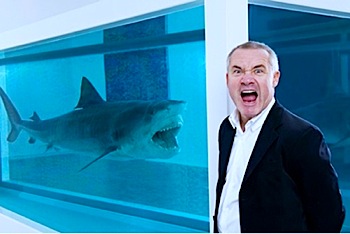
By David Ross. The more I am immersed in the study of art, the more I am appalled by what now passes as art … viscerally, even angrily appalled … and amazed that our culture – the culture of Palladio, Vermeer, what have you – sold its birthright for a mess of pottage that was not even tolerably good pottage. I recall an instructive day of cultural tourism in New York. My wife and I spent the morning at the Whitney, where we joined a sparse gaggle of pierced and alienated art-student types. We could not help noticing the mood of sour dutifulness that seemed to prevail. Nobody was enjoying and nobody was there to enjoy; the purpose was to symbolize one’s commitment to the modern, and to demonstrate one’s figurative manning of the barricades in the war against the bourgeois. After a while, I said to my wife, “Let’s get the hell out of this morgue.” We tried a palette cleanser of French pastry at Payard (see our wedding cake here), but the rancid taste was still in our mouths, and we felt the need for the stronger mouthwash of the Met. We wound up looking at Georgian furniture. Amid the gracefully tapering forms and magnificent burnishes, the public mood was all delight. Vacationing soccer moms stood before an impossibly lovely escritoire or settee and exclaimed, “How pretty! Kids, look at this one! Ooh, wow!”

The problem, just to be clear, is not modern art, but art that has abandoned the refinement of the hand and eye that marks the aesthetic. The problem is art’s increasing identification with aims that are not aesthetic at all, but political, sociological, commercial, sensational, and self-promotional, with impulses that are subversive but not beautiful in their subversion (as say Baudelaire and Toulouse-Lautrec were beautiful in their subversion). Turner has much in common with moderns like Jackson Pollock or Mark Rothko; he has nothing in common with a postmodern like Damien Hirst.
I constantly search for a definitive diagnosis of what’s gone wrong. Tom Wolfe’s The Painted Word (1975) is lucid and amusing, but even better, because more pissed off, is Theodore Dalrymple’s essay “Trash, Violence, and Versace: But is it Art?” (see here), a review of a 1998 exhibition called “Sensation.” The Royal Academy of Art, historically a bastion of the staid, was the offender in this case, which suggests how strangely and thoroughly the cultural life of the West has been perverted. Dalrymple is particularly roused by the vapid amorality of Marcus Harvey’s portrait of the mass-child-murderer Myra Hindley. The portrait is rendered in children’s handprints, and the parents of the murdered children naturally protested (not that anyone cared). Dalrymple comments:
There is nothing intrinsically wrong with painting a murderer, even one as depraved as Hindley. But there was undoubtedly something profoundly distasteful about the public display of the painting in this exhibition. The very title of the exhibition as a whole suggested titillation or voyeurism; and this is how the catalog describes the work of Marcus Harvey, two of whose other paintings, both of nude women, were also exhibited, one of them leeringly entitled, “Dudley, Like What You See? Then Call Me.” Marcus Harvey makes disquieting, tension-filled paintings that simultaneously contain and exceed their salacious imagery. Through the superimposition of pornographic female nudes on to a wildly expressionistic ground, form and content resist and comply with each other uneasily. What is a working-class mother from Manchester, who has had her child expressionistically, salaciously, and pornographically murdered, supposed to make of this?
I asked the Royal Academy’s chief of exhibitions, Norman Rosenthal. A man much reviled by some academicians (a few of whom resigned from the academy over the exhibition), he is clearly very good at his job. Somewhat grubby and unwashed, he has the charismatic capacity to antagonize at 100 yards; and when he speaks – hundreds of words to the minute – one feels one is listening to Mephistopheles.
“All art is moral,” he said. “Anything that is immoral is not art.”
There is no such thing, wrote Oscar Wilde, as a moral or an immoral book. Books are well written, or badly written. Presumably, then, Mein Kampf would have been all right had it been better written.
“The picture raises interesting questions,” continued Rosenthal.
“What interesting questions does it raise?” I asked. “Because it must be possible to formulate them in words.”
“It raises a question, for instance, about the exploitation of children in our society,” said Rosenthal.
“Some might say that the use of a child’s palm to produce a picture of a child murderer, when the child could not possibly appreciate the significance of the use to which its palm was being put, was itself a form of exploitation,” I replied.
Dalrymple builds toward a theory of this vileness. In essence, we are witnessing the mindless reflexes of a decadent romanticism:
The crudity of which I complain results from the poisonous combination of an ideologically inspired (and therefore insincere) admiration for all that is demotic, on the one hand, and intellectual snobbery, on the other. In a democratic age, vox populi, vox dei: the multitude can do no wrong; and to suggest that there is or ought to be cultural activity from which large numbers of people might be excluded by virtue of their lack of mental cultivation is deemed elitist and, by definition, reprehensible. Coarseness is the tribute that intellectuals pay, if not to the proletariat exactly, then to their own schematic, inaccurate, and condescending idea of the proletariat. Intellectuals prove the purity of their political sentiment by the foulness of their productions.
As for snobbery, the intellectual raises himself above ordinary folk – who still cling quixotically to standards, prejudices, and taboos – by his thorough rejection of them. Unlike others, he is not a prisoner of his upbringing and cultural inheritance; and thus he proves the freedom of his spirit by the amorality of his conceptions.
This is perfectly correct as far as it goes, but there is more – or rather something more basic – to be said. I return always to this comment from Yeats, which seems to me about the most profound and lovely thing ever said on the subject of the metaphysical prerequisites of art:
And it may be that men are only able to fashion into beautiful shapes the most delicate emotions of the soul, spending their days with a patience of the middle ages in the perfect rounding of a verse, or in the perfect carving of a flower, when they are certain that the soul will not die with the body and that the gates of peace are wide, and that the watchers are at their places upon the wall. (John Eglinton and Spiritual Art, 1898.)

There must, in short, be a watcher upon the wall, whether divine or otherwise. A century or more of iconoclasm, literal and figurative, has left the wall bare. Damien Hirst or Marcus Harvey may glance over their shoulder, but there is no hovering presence to make them ashamed of their littleness and their squalor, and to remind them that their fullest humanity is something owed. Every medieval stonemason understood as much.
As for Harvey’s portrait – needless to say, the mandarins of our wrecked culture continue to find it irresistible.
Dalrymple’s essay appears in his collection Our Culture, What’s Left of It: the Mandarins and the Masses, which also includes the classic essay “The Barbarians at the Gates of Paris,” about the banlieues of the French capital. It is the definition of mandatory reading.
Posted on August 7th, 2010 at 10:36am.
We tried a palette cleanser of French pastry at Payard.
I clicked over. Now that’s ART. Someone get them an NEA grant. Stat!
Like the arts commissars, I prefer a mechanistic approach to the problem of modern art as an arm of the left’s ministry of information.
Dalrymple: Intellectuals prove the purity of their political sentiment by the foulness of their productions.
Granted, but that doesn’t cover their motivation. Intellectuals need porsches (and patronage and accolades) too. Foul = sensational = publicity. The more publicity . . . well you get the idea. The “purity of political sentiment” is the protective coloration, the armor against the barbarians – and anyone with healthy aesthetic values as it turns out.
IMO, changing the cultural climate is a matter of connecting the government education arts complex more directly with the people who actually pay for it. Depose the arts council mandarins and replace with the soccer mom accounts managers. If they object we can say we’re simply emulating everybody’s arts ideal, Mao Zedong.
Now that would be delicious.
Heh. I’m sure the kids were loving the furniture, when they could be bothered to look up from texting. (when I was young, furniture exhibits were painful to be dragged through, and no cell phones then!) It may not be your thing, but there’s still some great modern stuff being made in the midst of the pretentious crap. I don’t care for the Koons you’re showing above, but I do smile when I see his giant, stainless steel “balloon” animals. (and I find Chris Burden’s installation “Urban Light” in front of the L.A. County Museum of art very charming). Since this is a movie site, may I recommend “Exit Through the Gift Shop,” a pretty great documentary on “street”art, fads, and hucksterism. Really should not be missed. The one benefit of pretty much anything being “art” is that anyone can try it. Eventually history will give us more masters, no watcher on the wall needed.
This was before the days of texting. I will be sure to see “Exit Through the Gift Shop.”
The notion that “anything is art” will not lead to “more masters,” but to no masters. Mastery is a technical function of the labor to transcend one’s everyday vision and understanding and the mundane trappings of the world. If anything and everything are art, this backbreaking labor is no longer required; the mastery of the hand and eye is no longer required. You wind up with exactly what we have: art that editorializes rather than floods the eye with beauty and meaning.
I respectfully disagree. Someone who tries sketching on a drugstore pad or making a collage out of magazine clippings (even after seeing even a pretentious modern exhibit) might try a fine arts course when they find they want to do better, just as a home cook might want to improve their cooking after having a fantastic meal or watching a tv cooking show. And maybe it might just be a hobby for them, but they’ll think highly enough of art to take their kids to museums and give them lessons early on.The less “exotic” the arts are, the more will try it. The more who try it, more will get hooked on it, and innovate, and eventually that’s where your new masters will come from. And the last time I checked, art schools that continue to teach classic techniques. And one might argue that art has _always_ editorialized–or what did you think all that magnificent classical religious art was for?
edited to add: I really wish there were an edit feature! I apologize for dropped parentheses and garbled syntax!